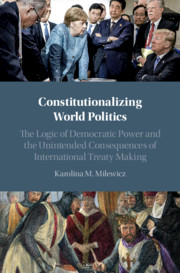 Constitutionalizing World Politics
Constitutionalizing World Politics Book contents
- Constitutionalizing World Politics
- Constitutionalizing World Politics
- Copyright page
- Dedication
- Contents
- Figures
- Tables
- Acknowledgments
- Abbreviations
- 1 Constitutionalization of World Politics – Seriously?
- Part I Constitutional Foundations
- Part II The Logic of Democratic Power in Treaty Making
- Book part
- Bibliography
- Index
- References
Bibliography
Published online by Cambridge University Press: 21 July 2020
- Constitutionalizing World Politics
- Constitutionalizing World Politics
- Copyright page
- Dedication
- Contents
- Figures
- Tables
- Acknowledgments
- Abbreviations
- 1 Constitutionalization of World Politics – Seriously?
- Part I Constitutional Foundations
- Part II The Logic of Democratic Power in Treaty Making
- Book part
- Bibliography
- Index
- References
- Type
- Chapter
- Information
- Constitutionalizing World PoliticsThe Logic of Democratic Power and the Unintended Consequences of International Treaty Making, pp. 301 - 343Publisher: Cambridge University PressPrint publication year: 2020


